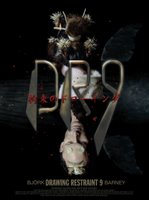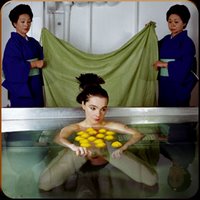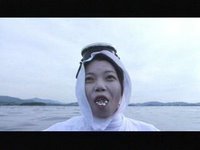[Finally, after a week and multiple promises, Fosco delivers his review of Matthew Barney's Drawing Restraint at the SFMOMA.] I've seen more Matthew Barney than most people. We go back a long way. I saw the original exhibit of Cremaster 2 at the SFMOMA in 2000. I spent an entire afternoon at the Guggenheim New York in 2003 to see the Cremaster Cycle exhibit. That fall, I spent over seven hours in a theater (in Grand Rapids, MI), watching the complete Cremaster Cycle. I hope this solidly establishes my Matthew Barney credentials...
I've seen more Matthew Barney than most people. We go back a long way. I saw the original exhibit of Cremaster 2 at the SFMOMA in 2000. I spent an entire afternoon at the Guggenheim New York in 2003 to see the Cremaster Cycle exhibit. That fall, I spent over seven hours in a theater (in Grand Rapids, MI), watching the complete Cremaster Cycle. I hope this solidly establishes my Matthew Barney credentials...
In all of my Matthew Barney contemplation, I have reached several conclusions:
- Only his films themselves are worthy of appreciation as art. Each film is generally accompanied by a physical exhibitions of sculpture, drawings, photographs and artifacts that relate to the film. This exhibition is never worthy of the film itself. Without the film, the sculptures are almost completely unevocative. His drawings tend to be either banal or incomprehensible. Sometimes the vitrines he designs for the display of drawings are pretty nifty, but come on--he just shouldn't be allowed to work in any medium besides film.
- Never has a Matthew Barney interview increased my understanding or enjoyment of one of his films. He is not to be listened to. Let the films speak for themselves.
- He needs an editor. Isn't it interesting how great writers are often improved by good editing? Do you ever read recent novels by famous writers and bemoan the fact that they are now too famous to admit editing? Art doesn't always spring forth from the mind of the artist in its most powerful form--sometimes the editor is necessary. Consequently, there are a few hours of Barney's Cremaster series that could be excised with no consequent diminishment of artistic merit.
 That being said, I need also to note one more thing: despite all of his faults, I love him. The Cremaster Cycle was one of the most transcendent art experiences of my life and I will continue to contemplate it for decades. Some future Halloween, I even plan to attend a costume party dressed as the "Entered Apprentice" from Cremaster 3 (picture at left). So, consequently, I approached the Drawing Restraint exhibit at SFMOMA with a great deal of anticipation.
That being said, I need also to note one more thing: despite all of his faults, I love him. The Cremaster Cycle was one of the most transcendent art experiences of my life and I will continue to contemplate it for decades. Some future Halloween, I even plan to attend a costume party dressed as the "Entered Apprentice" from Cremaster 3 (picture at left). So, consequently, I approached the Drawing Restraint exhibit at SFMOMA with a great deal of anticipation.The physical exhibit itself can be dispensed with by repeating one of my conclusions from above: "only the films themselves are worthy of appreciation as art." Now let's talk about the film.
 The most interesting new element in Matthew Barney's recent artistic milieu is the presence of his ladyfriend Bjork. As much as I hate to disagree with the dreamy Alex Ross (aka, Mr. "I'm hanging out at Carnaval in Brazil with Bjork and Matthew Barney, so SUCK IT, Anthony Tommasini!"), I'm not really a big fan of Bjork's music. In fact, apart from a song here or there (like "Bachelorette," which is an exceptional song), I think her best work was on Selmasongs, the soundtrack to Dancer in the Dark. In fact, as much as I love her whole "adorable Icelandic pixie" thing, I was beginning to think her a bit overrated. Her presence in the movie, therefore, worried me a bit.
The most interesting new element in Matthew Barney's recent artistic milieu is the presence of his ladyfriend Bjork. As much as I hate to disagree with the dreamy Alex Ross (aka, Mr. "I'm hanging out at Carnaval in Brazil with Bjork and Matthew Barney, so SUCK IT, Anthony Tommasini!"), I'm not really a big fan of Bjork's music. In fact, apart from a song here or there (like "Bachelorette," which is an exceptional song), I think her best work was on Selmasongs, the soundtrack to Dancer in the Dark. In fact, as much as I love her whole "adorable Icelandic pixie" thing, I was beginning to think her a bit overrated. Her presence in the movie, therefore, worried me a bit. I should not have feared. The film was phenomenal. Somehow, working together has allowed Barney and Bjork to do the best work of their careers. I've now seen it three times. Before we go further, go watch the trailer again.
Before we go too much further, it's time for a plot summary (such as it is...):
- the film opens with an exquisitely beautiful scene of a Japanese woman wrapping two halves of a krill fossil as gifts.
- we see sweeping helicopter shots of a Japanese port city and watch a crew of jumpsuited workers build a gleaming white dock on the water.
- a decorated tanker truck is pulled through a refinery, preceded by a parade of dancing Japanese dancers and children.
- the camera descends one of the smokestacks at the refinery, looking upward; we splash into a bath of golden petroleum and watch strands of bubbles flow toward the surface; a dark, whale-like shape passes over us and the titles, in bronze flensing-knife font, spread across the screen. This is probably the most beautiful shot in the film and it left me completely breathless. You can get a sense of it from the trailer.
- the tanker arrives at the whaling ship, the Nisshin Maru, on whose deck a large steel cast of Barney's "field symbol" (it's that lozenge-with-a-bar-through-it that you see all over his work) has been created. The field symbol is filled with liquid petroleum jelly. This is the third shot in the trailer.
- pearl divers put on makeup, prepare their equipment, and go diving. They come across a large floating chunk of ambergris.
- strung with colored paper, the Nisshin Maru pulls away from the dock and heads out to sea.
- the chef of the Nisshin Maru (in a very witty scene), cooks dinners of whale blubber (shaped like the "field symbol") with pomegranite seeds and prawns.
- Bjork, cute as a button in a red winter wrap and hiking boots, waits on the shore for a boat to pick her up. One does.

- Matthew Barney (as the other "Occidental Guest") waits on a pier for his motorboat, which arrives.
- Bjork arrives at the Nisshin Maru and is lifted on board in a basket; she is undressed and takes a bath. You see her naked from behind through a scrim--you just get a hint of public hair. Also, you see her remarkably pointy breasts underwater.
- MB arrives on board the boat, removes his furry, furry overcoat and has his beard shaved off.
- MB lays down to sleep on a tatami mat.
- during the night, the crew plays a mock game of whale-harpooning on the deck.
- as MB sleeps, a drunk crew-member slips into his quarters and shaves off MB's eyebrows and shaves a large bald swath on the top of his head from his forehead to his crown.
- the next morning, there is much unsuccessful whale hunting, but the ship does find and take onboard the large floating chunk of ambergris.
- Bjork has her hair done (with many sea anemones!) and is dressed in animal skins; MB awakes and is also dressed in strange clothing. MB does full frontal nudity in this scene (uncircumcised, it appears), but Bjork does not.

- Once they have been attired, they (eventually) enter the tea ceremony room. The tea master appears and MB speaks the first spoken line in the film (over an hour in at this point): "Please come in." A long ritualized tea ceremony follows, in which Bjork says her one line (in Icelandic): "Thank you for inviting me." After the tea, MB asks the tea master (in an extremely stilted manner): "Can you tell us something about the vessel?" This leads to a long monologue by the tea master about the history of the Nisshin Maru, about the special effects of the ambergris onboard, and about the psychological scars left by the Nisshin Maru's collision with a Greenpeace boat near Antarctica. Once this monologue is over, there are no remaining spoken words in the film (at least another hour at this point).
- as the tea ceremony goes on, the workers on the deck above have stowed the ambergris log in the hull and have cut the bar from the middle of the now-solid petroleum jelly field symbol. The bar is hoisted to a different part of the deck and is cut into blocks using flensing knives. The blocks of jelly are fed into the ships boiler and are melted.
- Night falls. Bjork and MB remain in the tea room alone. They begin to make out, animalistically. There is licking of faces and noses. It's hot. MB gets one of the anemone spines from her hair stuck into his forehead. She pulls it out. It's very hot. A storm blows up. The ship is now strangely deserted (except for the couple). The boiler begins to overflow with petroleum jelly and the jelly slowly begins to fill the tea room.

- This is where things get a little weird. A flensing knife floats into the room and MB picks it up and begins to cut Bjork's legs with it. Bjork picks up her dagger and cuts his legs in return. There is some blood, but not as much as there should be. The couple continues their cutting as the petroleum level rises. Eventually, they manage to cut off each other's feet. Then they keep cutting. They break for a moment to feed each other a delectable morsel from their own thighs--sashimi-style. "Mmmm... Delicious Bjork." This is upsetting, but their faces remain placid as they float in a "cloud" of hardening petroleum jelly. Eventually, they slice each other's legs off entirely. Somehow, their lower torsos transform into whale-like tails and blowholes appear in the backs of their necks. They dive into the oil.
- While MB and Bjork complete their transformation, the workers on the deck remove the sides of the field symbol mold and the unstable petroleum jelly begins to collapse on the deck.
- The Nisshin Maru is now surrounded by icebergs. We see two whales surface near the ship, blow, and dive again heading away from the ship. Is this MB and Bjork? Your guess is as good as mine.

- The "petrolatum" spirit, hiding belowdecks, begins to refill a mold with petroleum jelly.
- A pearl diver surfaces and spews pearls from her mouth. The pearls sink to the ocean floor and form two interlocking circles.
- A small concrete deck is pulled from the sea by a chain onto the dock next to the gleaming white one built early in the film. The concrete dock collapses under the weight of the model.
What could all this mean?
 Well, as you can tell, Barney's work is really more interesting for its images than for its stories. And you can tell which images made a serious impression on me. You can get a sense of many of these images from the trailer, luckily. As for the narrative, well, I wouldn't worry too much about it. Just consider it an opportunity to think for a while about ritual, social constraint, oil, and biological plasticity.
Well, as you can tell, Barney's work is really more interesting for its images than for its stories. And you can tell which images made a serious impression on me. You can get a sense of many of these images from the trailer, luckily. As for the narrative, well, I wouldn't worry too much about it. Just consider it an opportunity to think for a while about ritual, social constraint, oil, and biological plasticity. Why is this film so good (apart from the fact that it is so absolutely gorgeous)?
- Matthew Barney, finally, has learned to edit--at least to some extent. Granted, 145 minutes is not svelte, but five years ago this film would have been six hours long. In almost no scene does Barney let the action occur in real time. This is a significant improvement over several of the Cremaster films (especially 1, 4, and 5).
- Bjork's music is wonderful. She singlehandedly moves several slower scenes along with her music. Although Jonathan Bepler's music for several of the Cremaster films was interesting, it was never meant to be an equal partner to the visual images. I'm beginning to think that Bjork does her best work when she is contrained by having to write music for a film.
- It is such a thick text. You can spin so many interpretive webs from these dark materials. It's so allusive that many areas of knowledge are in play: Japanese culture, physics and chemistry, marine biology, whaling history and practice, and, of course, Barney's previous artistic work in both the Cremaster and Drawing Restraint series.
- It's totally sexy (and discomfiting at the same time). As Fosco has said recently: "I like things that make me horny and uncomfortable at the same time."












No comments:
Post a Comment